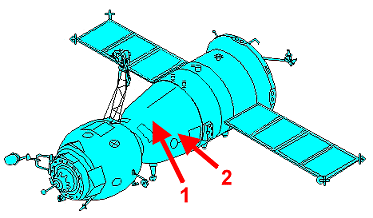Human Orbital Spaceflights
![]()
International Flight No. 71Soyuz T-2YupiterUSSR |
![]()
Launch, orbit and landing data
walkout photo |
 |
|||||||||||||||||||||||
alternative crew photo |
alternative crew photo |
|||||||||||||||||||||||
alternative crew photo |
||||||||||||||||||||||||
alternative crew photo |
||||||||||||||||||||||||
Crew
| No. | Surname | Given names | Position | Flight No. | Duration | Orbits | |
| 1 | Malyshev | Yuri Vasiliyevich | Commander | 1 | 3d 22h 19m 30s | 62 | |
| 2 | Aksyonov | Vladimir Viktorovich | Flight Engineer | 2 | 3d 22h 19m 30s | 62 |
Crew seating arrangement
|
 |
|
||||||||||||
Backup Crew
|
 |
|||||||||||||||
Hardware
| Launch vehicle: | Soyuz-U (No. Zh15000-196) |
| Spacecraft: | Soyuz T-2 (7K-ST No. 7L) |
Flights
|
Launch from the Baikonur Cosmodrome and
landing 200 km southeast of Dzheskasgan. Soyuz T-2 was a manned test flight of the new developed Soyuz T spacecraft. The craft had new engine systems and could launch three cosmonauts. Additionally, the Soyuz was equipped with a new Argon computer which controlled docking and reentry procedures. Six unmanned spacecraft of this new type had been tested before. Following a one-day solo flight Soyuz T-2 docked with the Salyut 6 space station on June 06, 1980 and common work with the fourth resident crew followed. The main goal of this flight was the testing and development of onboard systems in the improved Soyuz T series transport vehicle under piloted conditions. As the craft approached Salyut 6, solar cells, re-introduced to the Soyuz, were tested. The approach was completed automatically, while the final 180 meters were achieved manually on June 06, 1980. The Argon docking computer had failed, leaving the craft perpendicular to the station. The computer failure was later explained as being caused by the crew and controllers failing to have practiced the particular approach the computer chose. The crew had therefore chosen to dock manually to be safe; the computer would have successfully docked if allowed to, said the Soviets. However, failures during the automatic approach was a recurring problem in future Soyuz T missions. During their short stay, Yuri Malyshev and Vladimir Aksyonov seemed to have carried out a minimum of experiments, including participating in some medical tests and using the Salyut's MKF-6M camera. They undocked in the craft they arrived on only two days after first greeting the resident crew. As they left, the Salyut turned around and the Soyuz T-2 crew photographed and visually inspected the space station. The Soyuz then departed and landed about three hours later. The Soyuz spacecraft is composed of three elements attached end-to-end - the Orbital Module, the Descent Module and the Instrumentation/Propulsion Module. The crew occupied the central element, the Descent Module. The other two modules are jettisoned prior to re-entry. They burn up in the atmosphere, so only the Descent Module returned to Earth. The deorbit burn lasted about 3 to 4 minutes. Having shed two-thirds of its mass, the Soyuz reached Entry Interface - a point 400,000 feet (121.9 kilometers) above the Earth, where friction due to the thickening atmosphere began to heat its outer surfaces. With only 23 minutes left before it lands on the grassy plains of central Asia, attention in the module turned to slowing its rate of descent. Eight minutes later, the spacecraft was streaking through the sky at a rate of 755 feet (230 meters) per second. Before it touched down, its speed slowed to only 5 feet (1.5 meter) per second, and it lands at an even lower speed than that. Several onboard features ensure that the vehicle and crew land safely and in relative comfort. Four parachutes, deployed 15 minutes before landing, dramatically slowed the vehicle's rate of descent. Two pilot parachutes were the first to be released, and a drogue chute attached to the second one followed immediately after. The drogue, measuring 24 square meters (258 square feet) in area, slowed the rate of descent from 755 feet (230 meters) per second to 262 feet (80 meters) per second. The main parachute was the last to emerge. It is the largest chute, with a surface area of 10,764 square feet (1,000 square meters). Its harnesses shifted the vehicle's attitude to a 30-degree angle relative to the ground, dissipating heat, and then shifted it again to a straight vertical descent prior to landing. The main chute slowed the Soyuz to a descent rate of only 24 feet (7.3 meters) per second, which is still too fast for a comfortable landing. One second before touchdown, two sets of three small engines on the bottom of the vehicle fired, slowing the vehicle to soften the landing. |
Photos / Graphics
 |
 |
 |
 |
 |
 |
 |
 |
 |
 |
| © |  |
Last update on July 03, 2021.  |
 |